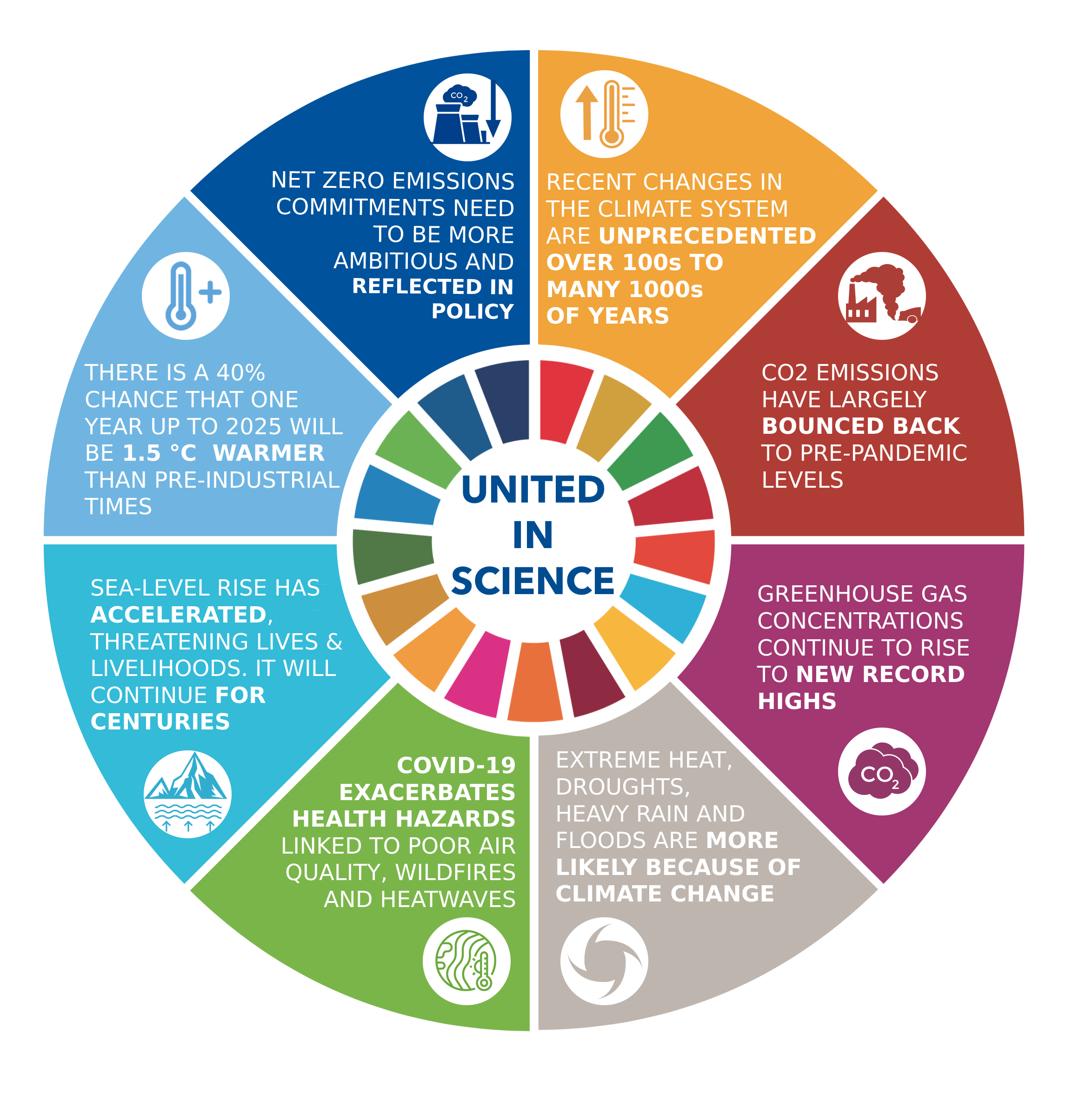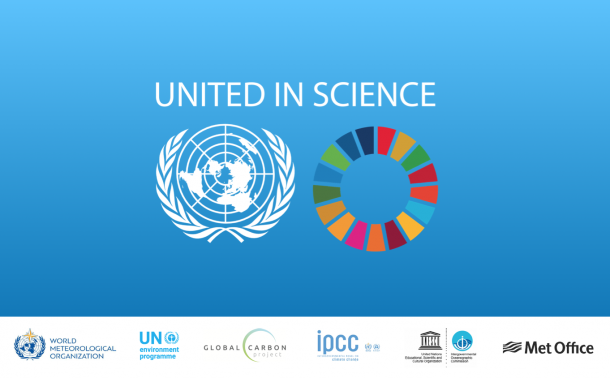COVID-19 did not slow the relentless advance of climate change. There is no sign that we are growing back greener, as carbon dioxide emissions are rapidly recovering after a temporary blip due to the economic slowdown and are nowhere close to reduction targets. Greenhouse gas concentrations in the atmosphere continue at record levels, committing the planet to dangerous future warming, according to a new multi-agency United in Science 2021 report.
Rising global temperatures are fuelling devastating extreme weather throughout the world, with spiralling impacts on economies and societies. Billions of work hours have been lost through heat alone. The average global temperature for the past five years was among the highest on record. There is an increasing likelihood that temperatures will temporarily breach the threshold of 1.5° Celsius above the pre-industrial era, in the next five years, the report said.
Through the UN Environment Programme, UNEP DTU Partnership has contributed to the chapter detailing the findings of the Emissions Gap Report.
“The new United in Science report is a unison and thunderous roar for a giant leap in climate action by the major climate science organisations, including WMO, UNEP and the IPCC. We are united in science, but more importantly: science is united! At UNEP DTU Partnership we feel privileged to have contributed key findings from the Emissions Gap Report to this important report”
Anne Olhoff, Head of Strategy for Climate Planning and Policy at UNEP DTU Partnership.
A critical year
The scale of recent changes across the climate system as a whole are unprecedented over many centuries to many thousands of years. Even with ambitious action to slow greenhouse gas emissions, sea levels will continue to rise and threaten low-lying islands and coastal populations throughout the world, according to the report.
“This is a critical year for climate action. This report by the United Nations and global scientific partner organizations provides a holistic assessment of the most recent climate science. The result is an alarming appraisal of just how far off course we are,” said UN Secretary-General Antonio Guterres.
“We are still significantly off-schedule to meet the goals of the Paris Agreement. This year has seen fossil fuel emissions bounce back, greenhouse gas concentrations continuing to rise and severe human-enhanced weather events that have affected health, lives and livelihoods on every continent. Unless there are immediate, rapid and large-scale reductions in greenhouse gas emissions, limiting warming to 1.5°C will be impossible, with catastrophic consequences for people and the planet on which we depend,” he said in the foreword.
The United in Science 2021 report, the third in a series, is coordinated by the World Meteorological Organization (WMO), with input from the UN Environment Programme (UNEP), the World Health Organization (WHO), the Intergovernmental Panel on Climate Change (IPCC), the Global Carbon Project (GCP), the World Climate Research Programme (WCRP) and the Met Office (UK). It presents the very latest scientific data and findings related to climate change to inform global policy and action.
“Throughout the pandemic we have heard that we must build back better to set humanity on a more sustainable path and to avoid the worst impacts of climate change on society and economies. This report shows that so far in 2021 we are not going in the right direction,” said WMO Secretary-General Prof. Petteri Taalas.
Key Points
Greenhouse Gas Concentrations in the Atmosphere (WMO Global Atmosphere Watch)
- Concentrations of the major greenhouse gases – carbon dioxide (CO2), methane (CH4) and nitrous oxide (N2 O) continued to increase in 2020 and the first half of 2021.
- Overall emissions reductions in 2020 likely reduced the annual increase of the atmospheric concentrations of long-lived greenhouse gases, but this effect was too small to be distinguished from natural variability.
- Reducing atmospheric methane (CH4 ) in the short term could support the achievement of the Paris Agreement. This does not reduce the need for strong, rapid and sustained reductions in CO2 and other greenhouse gases
Global Greenhouse Gas Emissions and Budgets (Global Carbon Project)
- Fossil CO2 emissions – coal, oil, gas and cement – peaked at 36.64 GtCO2 in 2019, followed by an extraordinary drop of 1.98 GtCO2 (5.6%) in 2020 due to the COVID-19 pandemic.
- The drop in CO2 emissions is temporary, and based on preliminary estimates, from January–May 2021 global emissions in the power, industry and residential sectors were already at the same level or higher than in the same period in 2019. Emissions from road transport remained about 6% lower.
- Recent emissions trends of N2 O, the third most important greenhouse gas after CO2 and CH4 , exceed the most greenhouse gases intense socioeconomic pathways used to explore future climate change.
Emissions Gap (UNEP)
- Five years after the adoption of the Paris Agreement, the emissions gap is as large as ever: global emissions need to be 15 GtCO2 e lower than current unconditional Nationally Determined Contributions (NDCs) imply for a 2 °C goal, and 32 GtCO2 e lower for the 1.5 °C goal.
- The COVID-19 crisis offers only a short-term reduction in global emissions. It will not significantly reduce emissions by 2030 unless countries pursue an economic recovery that incorporates strong decarbonization.
- The increasing number of countries committing to net-zero emission goals is encouraging, with about 63% of global emissions now covered by such goals. However, to remain feasible and credible, these goals urgently need to be reflected in near-term policy and in significantly more ambitious NDCs for the period to 2030.
Global Climate in 2017-2021 (WMO)
- The global average mean surface temperature for the period from 2017–2021 (based on data until July) is among the warmest on record, estimated at 1.06 °C to 1.26 °C above pre-industrial (1850–1900) levels.
- In every year from 2017 to 2021, the Arctic average summer minimum and average winter maximum sea-ice extent were below the 1981–2010 long term average. In September 2020, the Arctic sea-ice extent reached its second lowest minimum on record.
- 2021 recorded devastating extreme weather and climate events – a signature of human-induced climate change has been identified in the extraordinary North American extreme heat and west European floods.
Global Climate in 2021-2025 (WMO Global Annual to Decadal Climate Update – Met Office (UK), WCRP, WMO)
- Annual global mean near-surface temperature is likely to be at least 1 °C warmer than pre-industrial levels (defined as the 1850–1900 average) in each of the coming five years and is very likely to be within the range 0.9 °C to 1.8 °C.
- There is a 40% chance that average global temperature in one of the next five years will be at least 1.5 °C warmer than pre-industrial levels but it is very unlikely (~10%) that the 5-year mean temperature for 2021–2025 will be 1.5 °C warmer than pre-industrial levels.
- Over 2021–2025, high latitude regions and the Sahel are likely to be wetter than the recent past.
Highlights of the IPCC Sixth Assessment Report: The Physical Science Basis
- It is unequivocal that human influence has warmed the atmosphere, ocean and land. Widespread and rapid changes in the atmosphere, ocean, cryosphere and biosphere have occurred.
- The scale of recent changes across the climate system as a whole and the present state of many aspects of the climate system are unprecedented over many centuries to many thousands of years.
- Human-induced climate change is already increasing the frequency and intensity of many weather and climate extremes in every region across the globe.
Sea- level Rise and Coastal Impacts (World Climate Research Programme – WMO, IOC, ISC)
- Global mean sea levels rose 20 cm from 1900 to 2018 and at an accelerated rate of 3.7+0.5 mm/yr from 2006 to 2018.
- Even if emissions are reduced to limit warming to well below 2 °C, global mean sea level would likely rise by 0.3–0.6 m by 2100, and could rise 0.3–3.1 m by 2300.
- Adaptation to this residual rise will be essential – adaptation strategies are needed where they do not exist – especially in low-lying coasts, small islands, deltas and coastal cities.
Heatwaves, Wildfires, and Air Pollution: Compounding and Cascading Climate Hazards to Health (WHO/WMO)
- Rising temperatures are linked to increased heat-related mortality and work impairment, with an excess of 103 billion potential work hours lost globally in 2019 compared with those lost in 2000.
- COVID-19 infections and climate hazards such as heatwaves, wildfires and poor air quality combine to threaten human health worldwide, putting vulnerable populations at particular risk.
- COVID-19 recovery efforts should be aligned with national climate change and air quality strategies to reduce risks from compounding and cascading climate hazards, and gain health co-benefits.
“This report is clear. Time is running out. For the 2021 United Nations Climate Change Conference in Glasgow, known as COP26, to be a turning point, we need all countries to commit to net zero emissions by 2050, backed up by concrete long-term strategies, and enhanced Nationally Determined Contributions which collectively cut global emissions by 45 per cent by 2030, compared to 2010 levels,” said Mr Guterres.
“We need a breakthrough on protecting people and their livelihoods, with at least half of all public climate finance committed to building resilience and helping people adapt. And we need much greater solidarity, including full delivery of the long-standing climate finance pledge to help developing countries take climate action. There is no alternative if we are to achieve a safer, more sustainable and prosperous future for all.”


